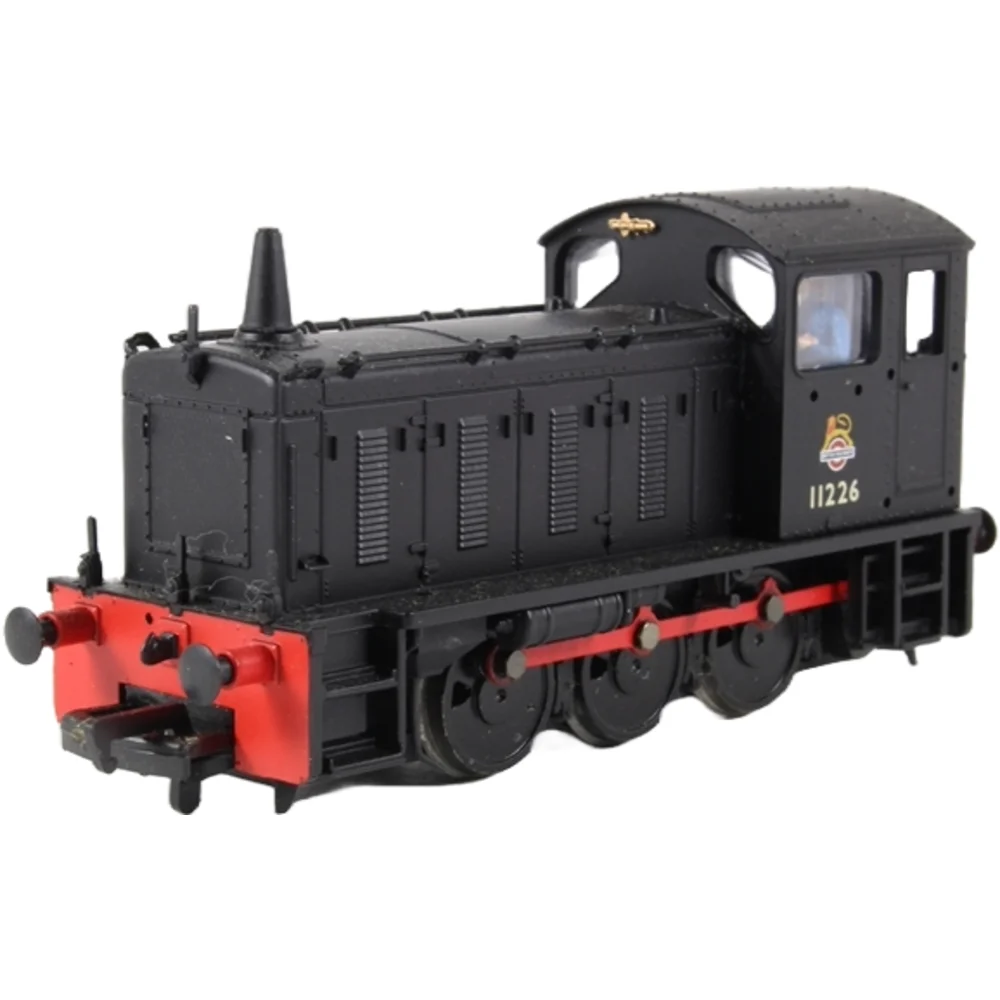Bachmann 31-335
British Rail Class 04 11226 British Railways Black with Early Emblem
Tooling
The Bachmann Branchline OO gauge Class 04 diesel-mechanical shunter was first introduced in 1997, marking a significant expansion of Bachmann’s small diesel shunter range. Built on a split-chassis platform derived from the earlier Class 03 tooling, this model offered an affordable and accessible option for enthusiasts seeking a classic industrial shunter for light-railway scenes.
Tooling Features
- Scale & Gauge: OO gauge (1:76 scale), faithful representation of the prototype.
- Construction & Detailing: Highly detailed injection-moulded body with separate handrails, cab fittings, and accurate ribbing on the sides. Some factory-fitted weathered versions featured paint blemishes that attracted minor aftermarket weathering upgrades.
- Chassis & Couplings: Employed a split chassis design common in late 1990s Branchline models. Built-in tension-lock style couplings; coupler pockets accepted NEM-compatible knuckle couplers with minor adjustments.
Mechanical & Electrical Features
- Motor & Drive: Traditional can-style motor driving through worm and gear set to a single axle, with pickup from all wheels.
- Minimum Radius: Suitable for layout curves as tight as standard OO second-radius track.
- Lighting: Factory-fitted incandescent cab and rear lights; direct-wired and not polarity-insensitive, prone to bulb burnout under modern wiring regimes.
- Weighting: Decent die-cast chassis provided moderate weight; some users added extra mass in the cab for smoother running.
DCC Capability
Originally released as DCC-incompatible—lacking decoder socket or wiring—users wishing to convert these models required hard-wiring decoders or retrofitting a 6-pin socket in the cab. Retrofit guides (such as those by Hookstone Models) show the feasibility of installing a linked 6-pin socket or board to support modern DCC decoders.
Liveries Produced
- BR Plain Black with early emblem and ‘112xx’ numbering
- BR Green with late crest and wasp stripes
- BR Blue with wasp stripes
- Factory weathered versions in Black, Green, and Blue
Reviews & Commentary
- YouTube Reviews: Many reviewers note the lack of NEM socket, basic lighting, and split chassis design, but praise the detail and low cost.
One reviewer described the model as a “6/10” for a faithful weathered homage despite limited modern features. - Budget Appeal: In hobby press and blogs, including a review by Jennifer Kirk, the 1997 Class 04 was singled out as one of the best affordable options from Bachmann—a reliable runner with solid detailing for the price.
Media & Social Media Feedback
- Discussions on RMweb/New Railway Modellers: Enthusiasts referenced the shared Class 03/04 1997 chassis and anticipated future reworkings for DCC and smoother motors.
- Conversion Guides: DIY tutorials by Hookstone Models and others show successful retrofits—adding 6-pin sockets to support plug-in decoders and minor re-gearing improvements.
- Maintenance Demos: Oorail’s video guide demonstrates easy access to gears and motors, reinforcing the model’s serviceable design ethos.
Interesting Notes
- The split-chassis concept, while cost-effective, was widely recognized as limiting DCC installation ease—fuelling Bachmann’s later decision to retool in 2013 for DCC readiness.
- Many modelers have enhanced realism through aftermarket weathering, new couplings, and smooth-running motor upgrades—a testament to the 1997 tooling’s flexibility.
Class & Prototype
- Class: British Rail Class 04
- Traction: Diesel
- Transmission: Mechanical
- Built: 1952-1961
- Total Built: 142
- Running Number: 11226
Operator & Livery
- Operator: British Railways
- Livery: Black with Early Emblem
- Era: 4 - British Railways Early Emblem
British Railways transformed Britain's fragmented rail network into a unified national system following nationalisation on 1st January 1948. Created from the "Big Four" companies under the Transport Act 1947, BR operated most of Great Britain's railways until rebranding as British Rail in 1965, managing over 20,000 route miles and inheriting nearly 20,000 locomotives of diverse designs.
The organisation pioneered standardisation through its revolutionary BR Standard locomotive programme (1951-1960), producing 999 advanced steam engines under Robert Riddles' direction. These included the versatile Britannia Pacifics, mighty 9F freight engines, and mixed-traffic classes that incorporated the best features from all predecessor companies. The 1955 Modernisation Plan accelerated diesel and electric traction development, creating fascinating mixed-traction operations.
Notable achievements included establishing unified locomotive classification systems, introducing distinctive corporate liveries, and managing the complex transition from steam to modern traction. BR's six regional structure preserved operational diversity whilst enabling standardisation of practices, signalling, and rolling stock that had eluded private enterprise for over a century.
The BR era represents steam traction's final flowering alongside emerging diesel technology, creating unparalleled locomotive variety. Today, this heritage remains highly popular with railway enthusiasts through extensive preserved fleets, heritage railway operations, and comprehensive model ranges from manufacturers like Hornby, Bachmann, and Dapol, making BR subjects essential for authentic post-war British railway modelling across all scales.
British Railways' plain black livery was designated specifically for freight and shunting locomotives from 1948, representing the most economical and practical finish for inherently dirty industrial machines. During the early nationalisation period, many locomotives were simply patch-painted over old company markings with black paint, which quickly weathered to match the existing finish as these engines were rarely cleaned. The "Lion and Wheel" emblem (nicknamed the "Cycling Lion") was introduced from December 1948 and applied to plain black locomotives from early 1949, featuring a lion standing over a large railway wheel with "British Railways" lettering across the centre.
The emblem was produced in three sizes and always faced forward, positioned centrally on tender sides or tank sides, with regional preferences evident—the Western Region favoured larger emblems whilst other regions used smaller versions. Plain black locomotives retained red buffer beams and received white "BRITISH RAILWAYS" lettering in Gill Sans style before the emblem's introduction. Some former company locomotives, particularly ex-GWR shunting engines, retained their original lettering well into the early 1960s as they didn't require renumbering and received minimal attention. This utilitarian livery remained standard for freight operations until the mid-1950s emblem change, making it essential for authentic early BR period modelling of goods yards, collieries, and industrial operations.
